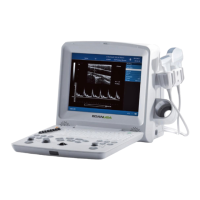DUS 60 Digital Ultrasonic Diagnostic Imaging System User Manual Specifications
- 150 -
Length of
probe
cable
2200±50 mm
Mode
Transducer Models Parameter(mm)
B B+M PW
F
LX
0.7188 0.7188 0.5274
L743UA
F
LY
7.8222 7.8222 4.635
F
LX
0.7188 0.7188 0.5274
E743UA
F
LY
7.8222 7.8222 4.635
F
LX
0.3902 0.3902 0.3943
L763UA
F
LY
2.2322 2.2322 2.5852
F
LX
0.6584 0.6584 0.8462
L742UA
F
LY
6.3649 6.3649 12.3959
F
LX
0.5431 0.5431 0.469
C613UA
F
LY
4.4323 4.4323 3.8273
F
LX
0.702 0.702 0.9829
E613UA
F
LY
7.4919 7.4919 12.649
F
LX
1.5429 1.5429 1.6648
C363UA
F
LY
20.3404 20.3404 22.1698
F
LX
1.5726 1.5726 1.7654
C343UA
F
LY
21.5005 21.5005 24.6285
F
LX
2.186 2.186 2.6236
C321UA
F
LY
42.2692 42.2692 54.189
F
LX
1.7369 1.7369 1.9452
C362UA
F
LY
26.6692 26.6692 33.9865
A1.8: Operating, Storage and Transportation Environment
A1.8.1. Operating Environment:
Temperature +5 °C ~ +40 °C
Relative humidity range 25% RH ~ 80% RH
Atmospheric pressure range 860 hPa ~ 1060 hPa
Maximum altitude 3 km
A1.8.2. Storage and Transportation Environment:
Temperature -20 °C ~ +55 °C
Relative humidity range 25% RH ~ 93% RH
Atmospheric pressure range 700 hPa ~ 1060 hPa
Maximum altitude 3 km
DUS 60 Digital Ultrasonic Diagnostic Imaging System User Manual Ultrasound Intensity and Safety
- 151 -
Appendix II: Ultrasound Intensity and Safety
A2.1: Ultrasound in Medicine
The use of diagnostic ultrasound has proved to be a valuable tool in medical practice. Given its
known benefits for non-invasive investigations and medical diagnosis, including investigation of
the human fetus, the question of clinical safety with regards to ultrasound intensity arises.
There is no easy answer to the question of safety surrounding the use of diagnostic ultrasound
equipment. Application of the ALARA (As Low As Reasonably Achievable) principle serves as a
rule-of-thumb that will help you to get reasonable results with the lowest possible ultrasonic
output.
The American Institute of Ultrasound in Medicine (AIUM) states that given its track record of
over 25 years of use and no confirmed biological effects on patients or instrument operators, the
benefits of the prudent use of diagnostic ultrasound clearly outweigh any risks.
A2.2: Ultrasound Safety and the ALARA Principle
Ultrasound waves dissipate energy in the form of heat and can therefore cause tissue warming.
Although this effect is extremely low with Transcranial Doppler, it is important to know how to
control and limit patient exposure. Major governing bodies in ultrasound have issued statements
to the effect that there are no known adverse effects from the use of diagnostic ultrasound,
however, exposure levels should always be limited to As Low As Reasonably Achievable (the
ALARA principle). You can control the ultrasonic power or patient exposure to ultrasound in any
of the following three ways:
z Adjust the pulse strength (amplitude)
z Adjust the duration of the pulse (pulse duration)
z Adjust the pulse rate (pulse repetition frequency or PRF)
To change these settings for your system, use the following controls:
Amplitude
The power setting directly influences the amplitude of the pulse burst. A higher setting increases
the amplitude, resulting in a higher ultrasound output at the probe.
Sample Volume
The Sample volume is the axial length of the area from which the Doppler signals are obtained.
The larger the sample volume, the longer the duration of the pulse burst, and consequently the
higher the ultrasound output and power.
Spectrum Velocity Scale
The higher the scale setting, the higher the pulse repetition frequency (number of pulses per
second), and consequently the higher the ultrasound output. More pulses per second are

